|
|
Advertisement:
|
|
ABIT IT7 Max2 Version 2 i845PE Motherboard |
|
Join the community - in the OCAU Forums!
|
Performance Comparison
Performance Comparison
Our performance baseline is the results obtained when we tested the predecessor; the 845E chipset based IT7 MAX 2 Version. The question is now: Is the 845PE based Version 2 providing better performance than the 845E based Version 1? A direct comparison is a little tricky and we have seen a few reviews with a confusing approach in this regard. In this report for example the IT7 MAX 2 Version 1 and Version 2 are compared with the Version 1 memory running at 133 (DDR 266) MHz and the Version 2 memory running at 166 MHz (DDR 333). That means that the FSB:RAM ratio of Version 1 was set to 1:1 and the FSB:RAM ratio of Version 2 to 4:5. The reviewer’s reason to do so was probably that the 845PE based Version 2 has “official” DDR333 support and the 845E based Version 1 has not. This is however somewhat misleading because (a) via a 3:4 ratio Version 1 has (even better) DDR 355 support and (b) such a comparison with the RAM at 133 MHz versus 166 MHz has little meaning. The result is anyway clear: The higher RAM frequency is providing higher bandwidth resulting in better performance in many applications.
We have already pointed out that the FSB:RAM ratio of the 845E based Version 1 can be set to 3:4. This brings the RAM frequency to 177.3 MHz (DDR 355). On the other hand: the 845PE based Version 2 (our test subject) can be set to 4:5, which brings the RAM frequency to 166 MHz (DDR 333). To compare the 2 versions running on these 2 different RAM frequencies would be again not exactly meaningful when the purpose is to compare chipset performance. We therefore decided to run both boards with a FSB:RAM ratio of 1:1. In this case performance differences must solely come from the chipsets itself and not from differences in the memory frequency. We set the front-site bus and the memory in the BIOS both at 133 MHz. As the CPU is quad-pumped it’s actually running at 533 MHz, and as the memory is DDR, it is actually running at 266 MHz. Day-to-day the user will of course run his Version 1 or Version 2 IT7 MAX 2 in a FSB: RAM ratio of 3:4 or 4:5 to enjoy a higher bandwidth. But the main purpose here is not to show the impact of a higher memory frequency on performance, but to compare the 2 chipset at equal footing.
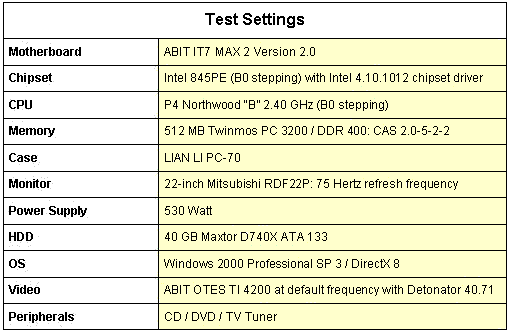
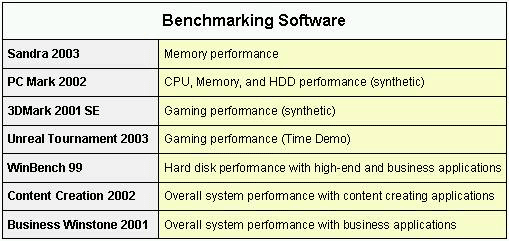
Etestinglab’s Content Creation 2002 and Business Winstone 2001 are application-based benchmarks that measure overall system performance when running Windows-based, 32-bit, content creation and business applications. In the same way a real user works, they keep multiple applications open at once and switch among them. Both are single large tests that run several applications through a series of scripted activities and return a single score. The other benchmarks are focused on the PC subsystems: MadOnion's 3DMark 2001 is mainly benchmarking the board’s graphic subsystem. The same goes for Unreal Tournament II 2003, one of the first game engines taking full advantage of DX8. WinBench 99 is benchmarking hard disk but has the advantage to test with actual applications. This is closer to a “real world” than the PCMark 2002 synthetic benchmarks for CPU, memory and HDD. All tests were repeated 3 times and the best score is reported here.
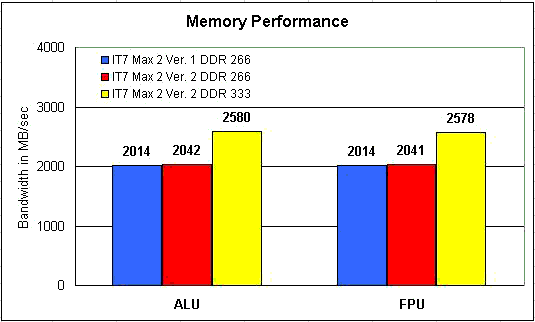
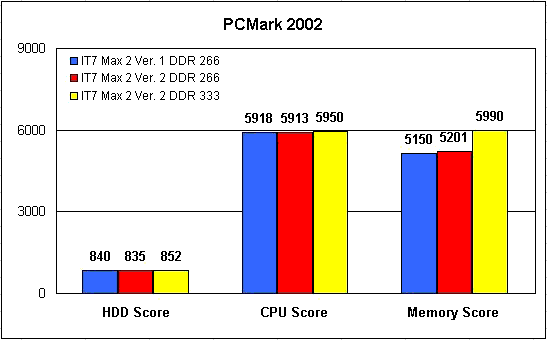
We were using Twinmos PC 3200/DDR 400 memory, which is a solid performer as shown here in our review. Sandra 2003 shows that the IT7 Version 2 delivers slightly better bandwidth when running the memory at DDR 266 specifications (2 x 133 MHz). A similar small advantage is visible in PC mark 2002. Running the memory as DDR 333 (2 x 166 MHz) is increasing bandwidth by more than 25%. But how much is this bandwidth increase actually boosting system performance when running applications?
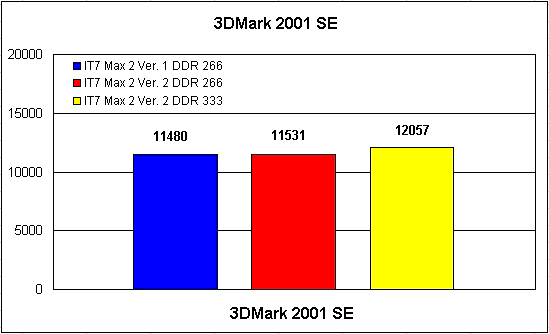
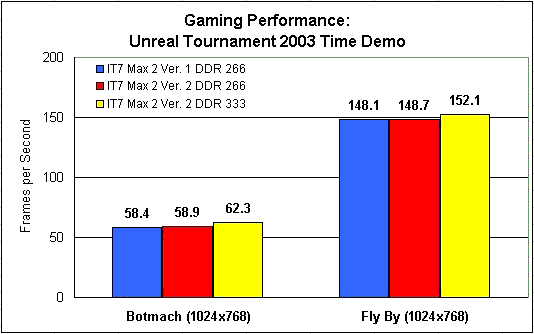
3DMark2001SE and the 2 Unreal Tournament 2003 time demos show that Version 2 has a hair thin advantage over Version 1 thanks obviously to the slightly better bandwidth. The gain when running the memory at 166 MHz DDR 333 is more substantial. We have to point out again, that Version 1 is also capable of running the memory at this speed when setting the FSB:RAM ratio in the BIOS to 3:4.
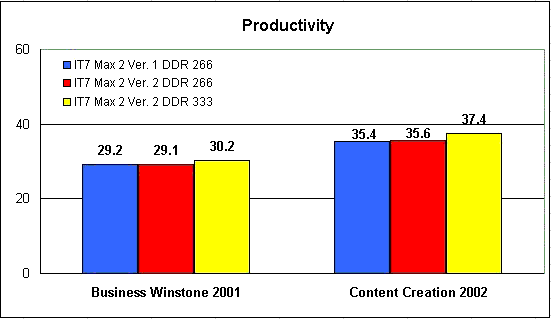
The productivity benchmarks returned a different picture. Content Creation and Business Winstone performed identical with IT7 Max 2 Version 1 and 2 when running both boards with a memory frequency of 133 MHz (DDR 266). Also interesting to see is that even when running Version 2 memory at 166 MHz (DDR 333) the scores went only up by around 4%. As already mentioned before, Content Creation and Business Winstone are measuring overall system performance. As application based benchmarks they are more “realistic” performance gauges than synthetic scores.
|
|
Advertisement:
All original content copyright James Rolfe.
All rights reserved. No reproduction allowed without written permission.
Interested in advertising on OCAU? Contact us for info.
|

|


